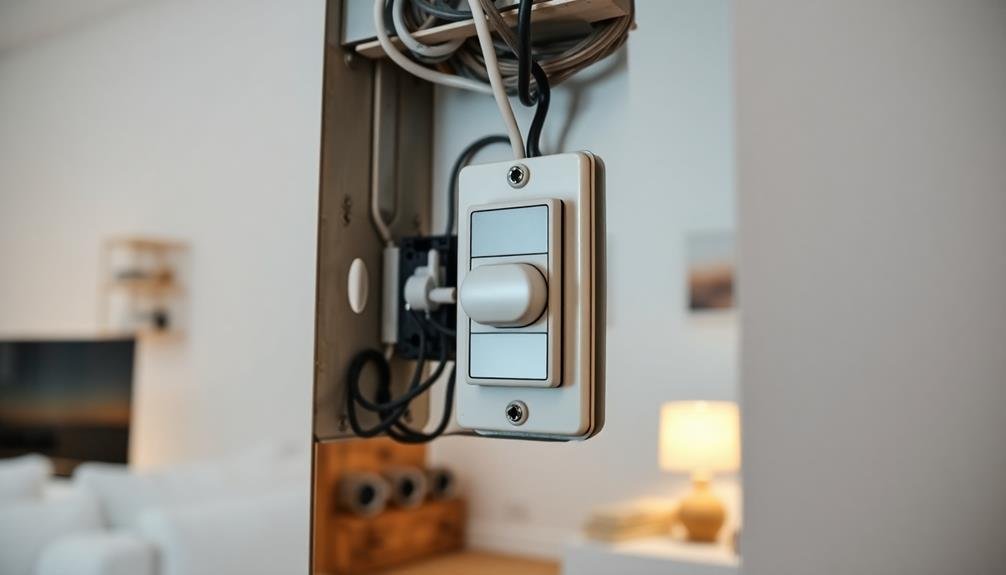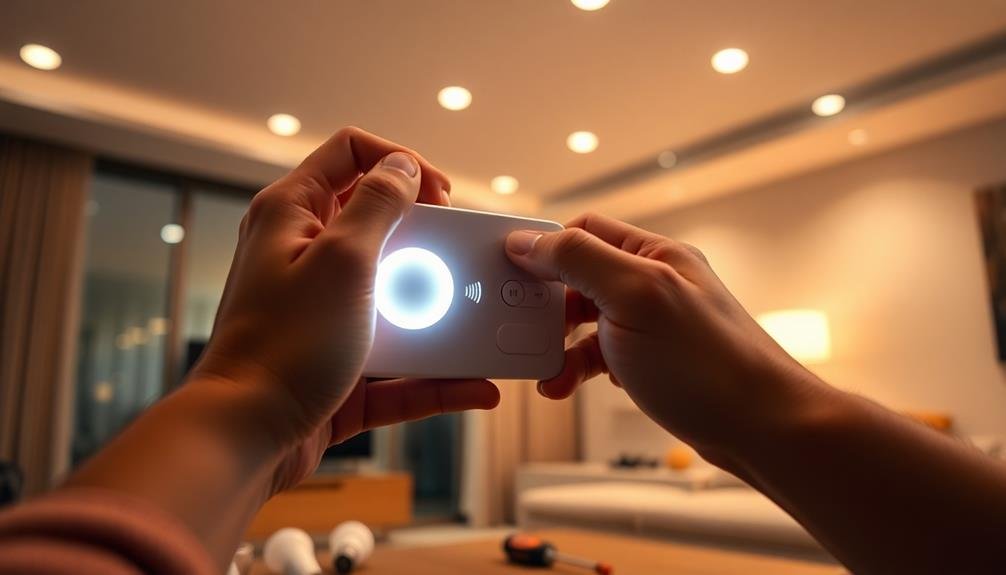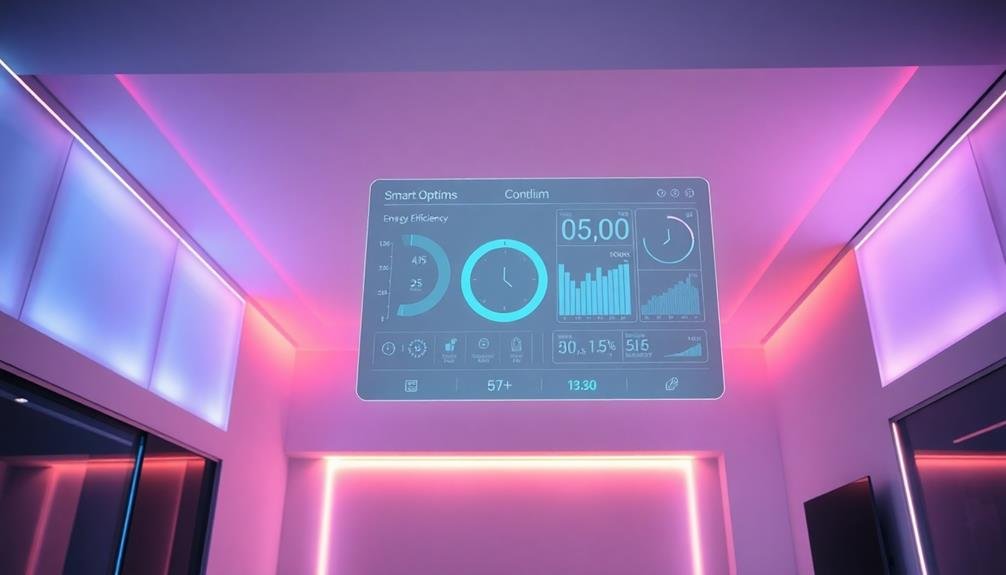LED dimming can enhance your home’s lighting, but compatibility is key. You’ll need dimmable LED bulbs and a compatible dimmer switch. Leading-edge dimmers work with some LEDs, while trailing-edge options offer smoother performance. Smart controls provide advanced features, but traditional wall-mounted dimmers are simpler.
To avoid issues like flickering or buzzing, choose LED-specific dimmers and match their wattage rating to your fixtures. When retrofitting, you may need to replace old switches with LED-compatible ones. Proper installation and troubleshooting can guarantee peak dimming performance. By understanding the nuances of LED dimming, you’ll be on your way to creating the perfect ambiance in every room.
Recommended Amazon Products for The Article Below:
- LED Bulbs Compatible with Dimmers
- Philips LED Dimmable A19 Smart Wi-Fi Light Bulb
- SYLVANIA LED A19 Dimmable Bulb, 60W Equivalent
- GE CYNC Smart LED Light Bulbs, Dimmable
2. LED-Compatible Dimmers
3. Traditional Dimmers for LED
4. Smart Dimming Solutions
5. Complete LED Dimming Kits
- Cynk by GE Smart LED Starter Kit with Smart Switch
- Philips Hue White Ambiance Starter Kit
- Lutron Caseta Wireless Dimmer Kit
Understanding LED Dimming Technology

When it comes to LED dimming, understanding the underlying technology is vital. LED dimming works differently from traditional incandescent bulbs, which simply reduce the voltage to lower light output.
LEDs, however, use a technique called pulse-width modulation (PWM) or constant current reduction (CCR) to achieve dimming effects.
PWM rapidly switches the LED on and off at a high frequency, creating the illusion of dimmed light. The longer the “off” periods, the dimmer the light appears. CCR, on the other hand, reduces the current flowing through the LED, directly lowering its light output.
You’ll encounter two main types of LED dimming: leading-edge and trailing-edge. Leading-edge dimmers were designed for incandescent bulbs and may not always be compatible with LEDs.
Trailing-edge dimmers are more suited for LED technology and often provide smoother dimming performance.
To guarantee compatibility, look for LED bulbs labeled as “dimmable” and check if your existing dimmer supports LED technology.
Some LEDs require specific dimmer types, so it’s vital to match your bulbs with the appropriate dimming system for peak performance and to avoid issues like flickering or buzzing.
Types of LED Dimmers
When selecting LED dimmers, you’ll encounter two main categories: leading-edge and trailing-edge dimmers, each with distinct compatibility profiles for different LED bulbs.
You’ll also need to choose between smart controls, which offer advanced features like remote operation and scheduling, and traditional controls that provide basic dimming functionality.
Understanding these options will help you pick the right dimmer for your LED lighting setup, ensuring smooth operation and peak performance.
Leading-edge vs. Trailing-edge Dimmers
Two main types of LED dimmers dominate the market: leading-edge and trailing-edge dimmers. Leading-edge dimmers, also known as TRIAC or forward phase-cut dimmers, were originally designed for incandescent bulbs. They work by cutting off the beginning of each AC sine wave. Trailing-edge dimmers, also called reverse phase-cut or ELV dimmers, cut off the end of each AC sine wave.
When choosing between these two types, consider your specific LED bulbs and fixtures. Trailing-edge dimmers generally offer smoother dimming and less flickering with LEDs, but they’re often more expensive. Leading-edge dimmers are more common and cheaper, but they may not work as well with some LED bulbs.
Here’s a quick comparison:
| Feature | Leading-edge | Trailing-edge |
|---|---|---|
| Compatibility | Most incandescent, some LEDs | Most LEDs, low-voltage lighting |
| Dimming range | Typically 10-100% | Often 0-100% |
| Flicker | More likely | Less likely |
| Cost | Lower | Higher |
| Noise | May produce buzzing | Generally quieter |
Always check your LED bulb’s specifications to verify compatibility with your chosen dimmer type. Some LED bulbs are designed to work with both types, offering greater flexibility in your lighting setup.
Smart vs. Traditional Controls
Beyond the technical differences between leading-edge and trailing-edge dimmers, you’ll need to contemplate the overall control system for your LED lighting. Your options fall into two main categories: smart controls and traditional controls.
Traditional controls are the familiar wall-mounted dimmers you’ve likely used for years. They’re simple, reliable, and don’t require internet connectivity. You’ll adjust light levels manually using a slider, knob, or button. These controls are often less expensive and easier to install, making them a practical choice for many homeowners.
Smart controls, on the other hand, offer advanced features and flexibility. They connect to your home’s Wi-Fi network, allowing you to control your lights remotely via smartphone apps or voice commands. You can create schedules, scenes, and even integrate your lighting with other smart home devices. Some smart dimmers also learn your habits and adjust automatically.
While smart controls provide convenience and energy-saving potential, they’re typically more expensive and may require professional installation. They also rely on internet connectivity, which can be a drawback if your network is unstable.
Consider your budget, technical comfort level, and desired features when choosing between smart and traditional controls for your LED lighting system.
Compatibility Issues With LED Bulbs

Despite their energy efficiency and longevity, LED bulbs can present compatibility challenges when paired with traditional dimming systems. You might encounter flickering, buzzing, or inconsistent light levels when using LEDs with older dimmers. These issues stem from the different electrical characteristics of LEDs compared to incandescent bulbs.
To guarantee smooth dimming, you’ll need to match your LED bulbs with compatible dimmers. Look for dimmers specifically designed for LED use, often labeled as “LED compatible” or “low-load” dimmers. Additionally, check the manufacturer’s recommendations for both the bulb and dimmer to confirm compatibility.
Here’s a quick guide to common LED dimming issues and their potential solutions:
| Issue | Cause | Solution |
|---|---|---|
| Flickering | Incompatible dimmer | Use LED-specific dimmer |
| Buzzing | Electrical interference | Install a noise suppressor |
| Limited dimming range | Minimum load not met | Add a dummy load or use multi-bulb fixture |
| Uneven dimming | Mixed bulb types | Use identical LED bulbs in a circuit |
Choosing the Right LED Bulbs
Selecting the right LED bulbs is vital for achieving ideal dimming performance. When shopping for dimmable LEDs, look for bulbs specifically labeled as “dimmable.” Not all LED bulbs are designed to work with dimmers, so this step is important.
Pay attention to the dimming range indicated on the packaging. Some LEDs can dim down to 10% or even 1% of their full brightness, while others may only dim to 20%. Choose a bulb with a dimming range that suits your needs.
Consider the type of dimmer you have or plan to install. Look for LED bulbs that are compatible with your dimmer technology, whether it’s trailing-edge, leading-edge, or universal. Many manufacturers provide compatibility lists on their websites.
Check the color temperature of the LED bulbs. Some LEDs maintain their color temperature when dimmed, while others shift to a warmer tone. Decide which effect you prefer for your space.
Lastly, consider the wattage equivalent and lumen output of the LED bulbs. Confirm they provide sufficient brightness for your needs when at full power, as dimming will reduce their light output.
Retrofitting Existing Dimmer Switches

Once you’ve chosen the right LED bulbs, you may need to address your existing dimmer switches. Many older dimmers aren’t compatible with LED technology, leading to flickering, buzzing, or inconsistent dimming.
To retrofit your system, start by identifying your current dimmer type. If it’s an older rotary or slider dimmer designed for incandescent bulbs, you’ll likely need to replace it.
Look for LED-compatible dimmers, often labeled as “trailing edge” or “electronic low voltage” (ELV) dimmers. These are designed to work with the lower wattage and different electrical characteristics of LED bulbs.
When selecting a new dimmer, verify it’s rated for the total wattage of your LED fixtures and check its minimum and maximum load requirements.
Installation typically involves turning off power at the circuit breaker, removing the old dimmer, and wiring in the new one. If you’re not comfortable with electrical work, hire a professional electrician.
After installation, test the dimmer with your LED bulbs to verify smooth operation across the full range of brightness. If problems persist, you may need to adjust the dimmer’s trim settings or consider a different model that’s more compatible with your specific LED bulbs.
Smart Dimming Solutions
As technology advances, smart dimming solutions have emerged as a versatile alternative to traditional dimmer switches. These innovative systems offer you enhanced control, convenience, and energy efficiency for your LED lighting setup.
Smart dimmers connect to your home’s Wi-Fi network, allowing you to control your lights through smartphone apps or voice assistants. You’ll be able to adjust brightness levels, set schedules, and create custom lighting scenes from anywhere. Some smart dimmers even learn your preferences over time, automatically adjusting light levels based on your habits.
When choosing a smart dimming solution, consider compatibility with your existing LED bulbs and fixtures. Look for systems that support various LED types and offer features like geofencing, which can automatically turn lights on or off based on your location.
Popular smart dimming options include standalone smart switches, plug-in modules, and integrated smart bulbs. Standalone switches replace your existing wall switches, while plug-in modules work with your current lamps. Smart bulbs with built-in dimming capabilities offer the easiest installation but may be more expensive to implement throughout your home.
Before investing in a smart dimming system, verify your home’s Wi-Fi coverage is adequate and consider any potential integration with other smart home devices you may have.
Common LED Dimming Problems

While smart dimming solutions offer advanced control, they’re not immune to issues that can plague LED dimming systems. You might encounter several common problems when dimming LED lights, regardless of the technology used.
Flickering is perhaps the most noticeable issue. Your LEDs may flicker or strobe, especially at lower dimming levels. This can be due to incompatibility between the dimmer and the LED driver or insufficient minimum load on the dimmer.
Another frequent problem is a limited dimming range. You may find that your LEDs don’t dim smoothly or don’t dim as low as you’d like. This often occurs when the dimmer’s minimum voltage is higher than the LED’s operating range.
You might also experience buzzing or humming sounds from either the dimmer or the LED bulbs themselves. This is typically caused by electromagnetic interference or poor quality components.
Dead travel is another issue, where a portion of the dimmer’s range doesn’t affect the light output. This can result in sudden jumps in brightness as you adjust the dimmer.
Lastly, some LEDs may turn off completely before reaching their lowest dimming point, leaving you with an abrupt shift from dim to dark.
Energy Savings With Dimmable LEDS
Dimmable LEDs offer substantial energy savings compared to traditional lighting options. When you dim an LED bulb, you’re not only reducing the light output but also decreasing its power consumption. This means you’re saving energy and lowering your electricity bills every time you adjust the brightness.
Unlike incandescent bulbs, which waste energy as heat when dimmed, LEDs maintain their efficiency across all brightness levels. You’ll typically save about 10% in energy for every 10% you dim an LED. So, if you dim your lights by 50%, you’re using roughly half the energy.
LED dimming also extends bulb lifespan. By operating at lower power, you’re reducing heat and stress on the LED components, potentially doubling or tripling the bulb’s life expectancy. This means fewer replacements and less waste over time.
To maximize energy savings, consider installing occupancy sensors or timers with your dimmable LEDs. These automation tools guarantee lights are only on when needed and at the appropriate brightness level.
You can also program smart dimmable LEDs to adjust automatically based on time of day or ambient light conditions, further optimizing your energy usage.
Installation Tips for LED Dimmers

When installing LED dimmers, you’ll need to guarantee proper wiring connections for peak performance.
You should carefully match the dimmer’s load capacity with your LED fixtures and use the correct wire gauge.
Additionally, consider the dimmer’s placement, keeping it away from heat sources and guaranteeing easy access for future adjustments or troubleshooting.
Proper Wiring Connections
Safety should be your top priority when installing LED dimmers. Before you begin, verify the power is off at the circuit breaker. Familiarize yourself with your dimmer’s wiring diagram and the existing wiring in your switch box. Most LED dimmers require a neutral wire, so confirm its presence before proceeding.
When making connections, follow these steps:
- Identify the wires: The black wire is typically “hot,” white is neutral, and green or bare copper is ground.
- Connect the dimmer’s black wire to the hot wire from the power source.
- Join the dimmer’s red wire to the wire leading to the light fixture.
Use wire nuts to secure all connections, making sure no bare wire is exposed. If your dimmer has a green ground wire, connect it to the ground wire in the box. For dimmers without a neutral wire connection, cap off the neutral wire in the box.
Double-check all connections before restoring power. If you’re unsure about any step, don’t hesitate to consult a professional electrician. Proper wiring is essential for the dimmer’s functionality and your safety.
Once installed correctly, your LED dimmer will provide smooth, efficient lighting control for years to come.
Dimmer Placement Considerations
Location is key when installing LED dimmers. You’ll want to place them in easily accessible areas for convenient operation. Typically, install dimmers at standard light switch height, about 48 inches from the floor. This guarantees most adults can reach them comfortably.
Consider the room’s layout when choosing dimmer placement. For bedrooms, position the dimmer near the bed for easy nighttime adjustments. In living rooms, place it near the main seating area. For open floor plans, install dimmers at entry points for immediate control upon entering the space.
Avoid placing dimmers near heat sources like radiators or in direct sunlight, as excessive heat can damage electronic components. Don’t install them in damp locations unless they’re specifically rated for such environments.
If you’re replacing an existing switch, you’ll likely use the same electrical box. However, if you’re adding a new dimmer, verify there’s adequate space in the wall cavity for the device and wiring.
For multi-way lighting circuits, you’ll need compatible dimmers designed for 3-way or 4-way setups. Install the main dimmer at the most frequently used switch location, with auxiliary switches at other points.
Dimming Range and Performance
Understanding dimming range and performance is essential when selecting LED lighting solutions. The dimming range refers to the span between the lowest and highest light output levels achievable by your LED lights. A wider range offers more flexibility in creating desired ambiance. However, not all LEDs dim equally, and their performance can vary considerably based on compatibility with your dimmer.
To guarantee peak dimming performance, consider these key factors:
- Minimum dimming level: Look for LEDs that can dim down to 1% or lower for a truly versatile lighting experience.
- Smoothness of dimming: High-quality LEDs should shift seamlessly between brightness levels without flickering or abrupt changes.
- Color consistency: Confirm your LEDs maintain consistent color temperature throughout the dimming range to avoid unwanted shifts in ambiance.
When testing your LED dimming setup, pay attention to any flickering, buzzing, or inconsistent behavior at different dimming levels. These issues often indicate incompatibility between the LED and dimmer.
To maximize performance, always choose dimmable LEDs and pair them with compatible dimmers designed for LED use. Remember that not all LEDs are dimmable, and using non-dimmable LEDs with a dimmer can lead to poor performance or even damage to your lighting system.
Evaluating LED Dimmer Quality

When selecting an LED dimmer, it’s important to evaluate its quality to guarantee peak performance and longevity. Look for dimmers from reputable manufacturers with a track record of producing reliable products. Check for certifications like UL or ETL, which indicate compliance with safety standards.
Pay attention to the dimmer’s load capacity and verify it matches your lighting setup. A high-quality dimmer should offer smooth, flicker-free operation throughout the entire dimming range. It’s worth investing in dimmers with advanced features like preset scenes or wireless control for added convenience.
Read customer reviews and professional evaluations to gauge real-world performance. Look for feedback on noise levels, as quality dimmers should operate silently without buzzing or humming.
Heat dissipation is another vital factor; well-designed dimmers shouldn’t overheat during extended use.
Consider the dimmer’s compatibility with various LED bulb types and brands. The best dimmers offer broad compatibility, reducing the likelihood of issues with future bulb replacements.
Troubleshooting LED Dimming Issues
Despite careful selection and installation, you may still encounter issues with LED dimming from time to time. Common problems include flickering, buzzing, or inconsistent light levels. To troubleshoot these issues, start by checking the compatibility between your LED bulbs and dimmer switch. Verify you’re using dimmable LEDs and a dimmer designed for LED use.
If compatibility isn’t the issue, try these steps:
- Adjust the dimmer’s low-end trim: This setting controls the minimum power output and can eliminate flickering at low levels.
- Replace old or incompatible bulbs: Mixing different brands or types of LEDs can cause inconsistent dimming performance.
- Install a neutral wire: Some modern dimmers require a neutral wire for peak performance with LEDs.
If problems persist, consider the possibility of electrical interference from nearby devices or poor wiring connections. You might need to install a noise suppression device or have an electrician inspect your wiring.
Remember that not all LEDs are created equal, and some may simply not work well with certain dimmers. In such cases, experimenting with different LED brands or upgrading to a more advanced dimming system might be necessary to achieve the desired dimming performance.
Future of LED Dimming Technology

As LED dimming technology evolves, you’ll see greater integration with smart home systems.
You can expect more sophisticated wireless dimming options, allowing for seamless control from your mobile devices.
These advancements will enhance your ability to create customized lighting environments and improve energy efficiency in your home.
Smart Home Integration
How will LED dimming evolve in the smart home of tomorrow? As technology advances, you’ll see LED dimming become more integrated with your home’s smart ecosystem. Voice-controlled dimming through virtual assistants like Alexa or Google Home will become standard, allowing you to adjust your lighting hands-free.
You’ll also find more sophisticated automation options, with your lights adapting to your daily routines and preferences without manual input.
Smart LED dimming will offer enhanced features such as:
- Circadian rhythm lighting that mimics natural daylight patterns
- Occupancy-based dimming that adjusts brightness based on room usage
- Energy optimization that balances lighting levels with power consumption
These advancements will make LED dimming more intuitive and energy-efficient. You’ll be able to create custom lighting scenes for different activities or moods, which can be activated with a single command or automatically triggered by time of day or other smart home events.
As LED dimming technology continues to evolve, you’ll see improved compatibility with various smart home platforms, making it easier to integrate your lighting with other connected devices and create a truly cohesive smart home experience.
Wireless Dimming Advancements
Three key wireless dimming advancements are set to revolutionize LED lighting control in the near future.
First, you’ll see improved Bluetooth mesh networks that allow for seamless control of multiple LED fixtures across larger spaces. This technology will enable you to adjust lighting in different rooms or even entire buildings from a single device, with minimal latency.
Second, expect to see more sophisticated voice-controlled dimming systems. These will integrate with popular smart home assistants, allowing you to adjust your LED lighting using natural language commands. You’ll be able to create complex lighting scenes and adjust brightness levels hands-free.
Lastly, watch for advancements in Li-Fi technology. This innovative system uses light waves to transmit data, potentially turning your LED fixtures into wireless internet access points. While primarily focused on data transmission, Li-Fi could also revolutionize how you control your lighting, offering ultra-fast response times and enhanced security.
These wireless dimming advancements won’t only make controlling your LED lighting more convenient but also more energy-efficient.
As these technologies mature, you’ll find it easier than ever to create the perfect lighting atmosphere in your home while reducing your energy consumption.
Frequently Asked Questions
Can LED Dimming Affect the Lifespan of My Bulbs?
Yes, LED dimming can affect your bulbs’ lifespan. If you’re using incompatible dimmers, you might shorten their life. However, when you use proper LED-compatible dimmers, you can actually extend your bulbs’ longevity while saving energy.
Are There Any Health Benefits Associated With Using Dimmable LED Lights?
You’ll find some health benefits with dimmable LED lights. They can reduce eye strain, improve sleep quality by mimicking natural light cycles, and lower stress levels. You’ll also enjoy better mood regulation and increased productivity in your living spaces.
How Do LED Dimmers Impact Home Security Systems?
LED dimmers typically don’t interfere with home security systems. However, you’ll want to guarantee your dimmer switch is compatible with your LED bulbs to avoid flickering, which could trigger motion sensors unnecessarily. Always check compatibility before installation.
Can LED Dimming Interfere With Other Electronic Devices in My Home?
Yes, LED dimming can potentially interfere with other electronic devices in your home. It might cause radio frequency interference, affecting Wi-Fi signals, smart home devices, or audio equipment. You’ll want to use quality dimmers to minimize these issues.
Are There Any Special Considerations for LED Dimming in Outdoor Lighting?
When dimming outdoor LEDs, you’ll need weather-resistant dimmers and fixtures. Consider temperature fluctuations, moisture, and voltage drop for long wire runs. Guarantee proper grounding and use compatible dimming systems designed for outdoor use to avoid flickering or malfunction.
In Summary
You’ve now got the knowledge to navigate LED dimming in your home. Remember, compatibility is key when selecting bulbs and dimmers. Don’t hesitate to upgrade your switches or invest in quality components for the best performance. If you encounter issues, refer to our troubleshooting tips. As technology advances, you’ll see even more efficient and user-friendly LED dimming options. Embrace this energy-saving lighting solution and enjoy the perfect ambiance in every room.





Leave a Reply